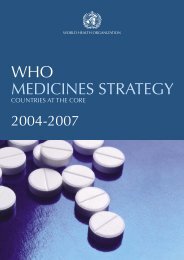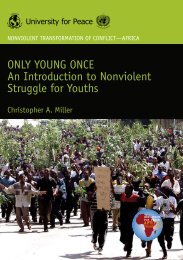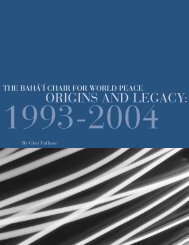environmental degradation as a cause of conflict in - Steiner Graphics
environmental degradation as a cause of conflict in - Steiner Graphics
environmental degradation as a cause of conflict in - Steiner Graphics
You also want an ePaper? Increase the reach of your titles
YUMPU automatically turns print PDFs into web optimized ePapers that Google loves.
zone southward — and to use these all for detailed and through studies toshow how these factors had been work<strong>in</strong>g separately or together, to producethe ongo<strong>in</strong>g situation <strong>in</strong> Umm Kaddada area at the time <strong>of</strong> study (mid-eighties).The second step w<strong>as</strong> to f<strong>in</strong>d out whether the ongo<strong>in</strong>g situation w<strong>as</strong> reversible orirreversible by forec<strong>as</strong>t<strong>in</strong>g the prospect <strong>of</strong> these <strong>in</strong>dicators. The ultimate aim <strong>of</strong> allthese stages <strong>of</strong> enquiry w<strong>as</strong> to save and preserve the rest <strong>of</strong> the region’s potentialbefore it w<strong>as</strong> too late.This goal could only be achieved through <strong>in</strong>tensive research <strong>in</strong> the region whichshould identify and analyze the most effective factors responsible for the <strong>degradation</strong>or upgrad<strong>in</strong>g <strong>of</strong> the region’s socio-economic structure. The available dataabout this neglected part <strong>of</strong> the country could hardly permit any sort <strong>of</strong> monitor<strong>in</strong>gprogramme, let alone plann<strong>in</strong>g for future development. The need for gather<strong>in</strong>gcurrent <strong>in</strong>formation about this region w<strong>as</strong> becom<strong>in</strong>g <strong>in</strong>cre<strong>as</strong><strong>in</strong>gly, vital, especially<strong>in</strong> regard to the recent regionalization policy and the proposed development strategiesfor the whole country <strong>in</strong> general and Southern Darfur <strong>in</strong> particular.We believed that the <strong>in</strong>cre<strong>as</strong>ed <strong>degradation</strong> processes <strong>of</strong> this region would affectadversely the development programmes <strong>in</strong> the whole Darfur prov<strong>in</strong>ce if it w<strong>as</strong> onlyseen <strong>in</strong> the <strong>in</strong>cre<strong>as</strong>ed out migration and concentration <strong>of</strong> people <strong>in</strong> a few are<strong>as</strong>which still had reward<strong>in</strong>g potentials. In the longer prospect this concentration, ifnot duly avoided, or modified, would produce the same features prevail<strong>in</strong>g <strong>in</strong> UmmKaddada area at that time.The ultimate aim <strong>of</strong> the proposed study <strong>in</strong> that area w<strong>as</strong> not only to reversethe process <strong>of</strong> <strong>degradation</strong> <strong>in</strong> Umm Kaddada area, but to protect adjacent regionsaga<strong>in</strong>st that <strong>degradation</strong>.F<strong>in</strong>d<strong>in</strong>gs <strong>of</strong> the Field Investigations:• The spread <strong>of</strong> desert-like conditions <strong>in</strong> the area <strong>of</strong> study had created a seriousecological imbalance, ma<strong>in</strong>ly <strong>cause</strong>d by the recent <strong>environmental</strong> deterioration,<strong>in</strong> terms <strong>of</strong> decre<strong>as</strong><strong>in</strong>g amount <strong>of</strong> ra<strong>in</strong>fall, <strong>as</strong> well <strong>as</strong> the rapid<strong>in</strong>cre<strong>as</strong>e <strong>of</strong> human and animal population, particularly <strong>in</strong> the sixties andseventies <strong>of</strong> the l<strong>as</strong>t century.• It w<strong>as</strong> clearly shown by our <strong>in</strong>vestigations that aridity w<strong>as</strong> an <strong>in</strong>fluentialfactor for enhanc<strong>in</strong>g <strong>degradation</strong> <strong>of</strong> soil, which <strong>in</strong> turn led to decre<strong>as</strong>ed landproductivity, culm<strong>in</strong>at<strong>in</strong>g <strong>in</strong> food shortage.• The quick regeneration <strong>of</strong> the natural ecosystem under the persistence <strong>of</strong>man’s impact w<strong>as</strong> found to be difficult.50











